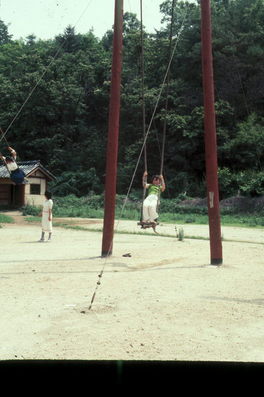 =0=
=0= =0=
=0= =0=
=0=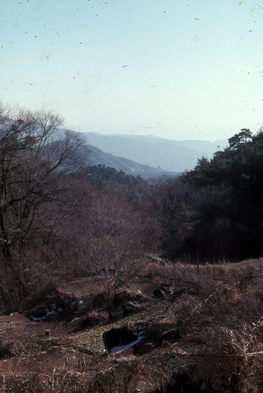 =0=
=0=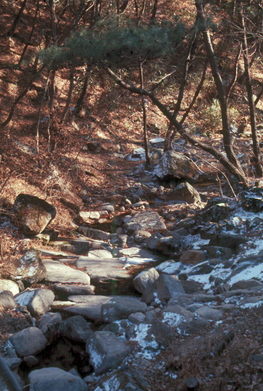 =0=
=0=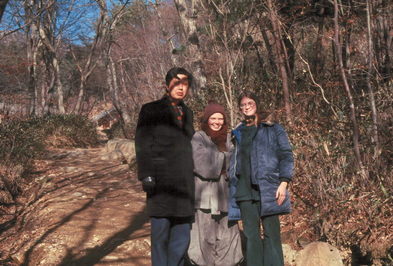 =0=
=0=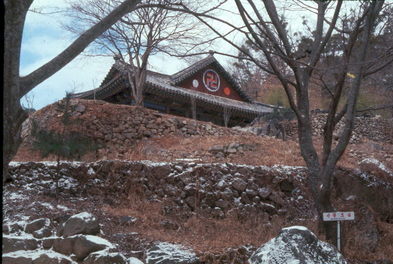 =0=
=0= =0=
=0=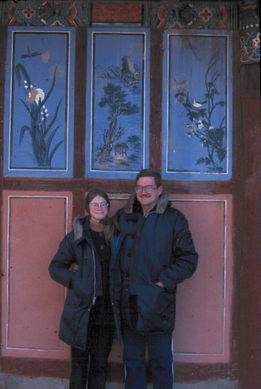 =0=
=0=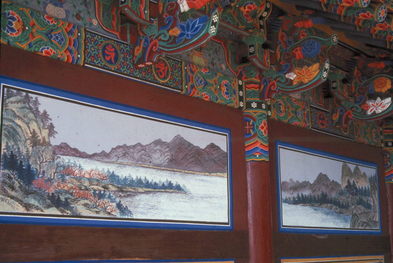 =0=
=0= =0=
=0= =0=
=0=| This (and below) is a traditional Korean swing. Rather than sitting on the swing and rotating the body like Americans commonly do, they crouch (on way down) and stand up (on way). That was interesting because in graduate school there was a seminar on problem solving, and, as exercises we considered various problems one of which was how people swing (what laws of physics do they use). The American swinging technique relies on angular momentum. The Asian technique relies on conservation of energy. |  =0=
=0= |
 =0=
=0= |
 =0=
=0= |
| This is the view from Dong Wah Sah, a monastery we visited with Mr. Nam in February (there was still snow on the ground). While we were in Korea, Barbara would tutor Koreans in English. Mr. Nam was one of her students and taught English in high school. Koreans could often read and write English quite well (as most university textbooks were in English). However, their pronunciation was often not very good.... The monasteries are normally located in pretty isolated, but quite beautiful areas. |  =0=
=0= |
| This is the path to the monastery. It was a nice easy path. |  =0=
=0= |
| This is Mr. Nam, a buddhist monk, and Barbara. The monk was an English woman, but with her garb it and shaven head was hard to tell her sex until you talked with her. When the other monks noticed that there were two Americans visiting, they went and got the English monk and we visited with her over lunch. She had been there about three months and had been making good progress at learning Korean but missed speaking English. Barbara is wearing her parka which were popular with visiting Americans. Most inexpensive at $12. |  =0=
=0= |
| This is one of the temples as we appraoched. We were a little shocked to see what appeared to be a Nazi Swastika, but is actually a Buddhist marking (the Nazis inverted it for their Swastika) which, in India, means peace and harmony (being at one with your karma). Quite an appropriate marking for a Buddhist temple. |  =0=
=0= |
| This is Mr. Nam in front of a Buddhist shrine. There are numerous shrines around the countryside, but while most of the pictures that you might see are of the more impressive and larger shrines, this would be a more typical one. |  =0=
=0= |
| Here is are Barbara and I standing beside some of the murals which decorated the outside of this (and most other) shrines. See the matching parka? |  =0=
=0= |
| Here are some murals on the interior walls as well as a view of ceiling. The roof and ceiling of the shrines are made from whole logs. While most of the Korean shrines are decorated in pretty subdued colors, the underside of the celing/roof logs are often painted with beautiful designs in bright colors. This is in contrast to Japanese and Thai temples which each have their own characteristic style. |  =0=
=0= |
| This is another view of the ceiling of the shrine. |  =0=
=0= |
| Most of the temples and monasteries that we visited had a very large bell that we presumed were used in the monks practices, though we never heard them ringing the bell. With each large bell there is commonly a large log (carved in the shape of a fish in this case) which hangs on two ropes so that it can swing laterally. Once it is swinging it can then strike the bell. This bell and striker were surrounded by fences and such so that I couldn't get a good picture. |  =0=
=0= |
This page was last updated on September 4, 2005.